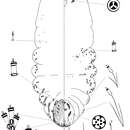Description
(
Anglèis
)
fornì da Zookeys
Field characters: All pine-feeding Chionaspis reported here, including Chionaspis heterophyllae and Chionaspis pinifoliae are indistinguishable by eye in the field. See the description above for Chionaspis brachycephalon Vea.
Slide-mounted adult female (Figure 3) spindle-shaped and elongate, lobed laterally and broader posteriorly (broadest at metathorax or abdominal segment 1), length of holotype 1.29 mm, range (n=10) 1.29 – 1.83 mm; maximum width of holotype: 0.59 mm; range (n=10) 0.59 – 0.7 mm.
Pygidium: Lobes. Posterior margin with 3 pairs of definite lobes, fourth pair of lobes appearing as series of low, sclerotized points; paraphyses absent. L1 separated by space 0.3 times width of lobes, with a horseshoe-shaped yoke, lateral margins of lobes divergent, medial margin parallel from the base to midpoint, then diverging in apical half (with notches on diverging part); L2 bilobed, entire, shorter than L1, medial lobule larger; L3 slightly notched on lateral side or entire, bilobed but with outer lobule membranous, subequal or slightly smaller than inner lobule. Gland spines. Gland spine formula 1-1-1 (microduct formula 1-1-1), with 1 gland spine near each body margin of abdominal segment 5; without gland spines between L1. Ducts. Large macroducts in submedian area of segments 5 and 6 (with 4 – 7 (5) on segment 5 and 4 – 5 (5) on segment 6), in submarginal areas of segment 5 (with 5 – 7 (7)), and in marginal area of segments 5 to 7 (with 1 on segment 7, 2 on segment 6, 2 on segment 5); absent on segment 8. Largest macroduct on segment 7 (between L1 and L2) 15 – 20 (17.5) μm long. Small macroducts sparse on segment 5 (sometimes 2). Pygidial microducts on venter in submarginal areas of segment 5 to 7, with 0 – 2 (2) ducts on segment 5, 1 – 4 (2) ducts on segment 6 and 1 – 2 (2) ducts on segment 7; pygidial microducts absent from dorsum. Pores. Perivulvar pores with 5 loculi, in 5 groups, 1 median with 12 – 24 (15) pores, 2 anterolateral with 24 – 35 (28) pores, 2 posterolateral with 27 – 33 (30) pores. Anal opening. Located 7.7 – 16.3 (11) times length of anal opening from base of median lobes, diameter 10 – 17.5 (14.5) μm long. Setae. Dorsal setae: 2 setose on L1, 1 setose (~ 11 µm) between lobules of L2 and L3. Ventral setae: 1 small on L1, 1 marginal at base of each gland spine cluster and 1 on submarginal area of each segment, 2 in submedian area of segment 6, half as long as dorsal setae; 2 pairs of setae in a row anterior to the vulva.
Prepygidium: Gland spines. Near each body margin from segment 2 to 4, absent from mesothorax, metathorax and segment 1; 4 – 8 (6) on segment 2, 4 – 7 (5) on segment 3 and 1 – 4 (2) on segment 4. Gland spines on segments 3 and 4 protruding from margin and about same size as those on segment 5. Gland spines on segment 2 the smallest and never protruding from the margin. Ducts. Macroducts of 2 sizes; larger macroducts in submedian areas of abdominal segments 4 and 3. Small macroducts in submedian area of any or all of segments 3 and 4, in marginal areas from meso- or metathorax to segment 3. Prepygidial microducts almost absent on both surfaces, with a few on segment 2.
Cephalothorax: Microducts sparse on venter and dorsum, with a slight concentration around posterior thoracic spiracles and head. Perispiracular pores with 3 loculi, anterior spiracles with 5 – 6 (6) pores, posterior spiracles with 1 – 3 (2) pores. Eyes represented by small sclerotized area, located on body margin at level near anterior clypeolabral shield. Antennae each with 1 long seta and 2 minute setae, distance between antennae 60 – 117.5 (80) µm.
- licensa
- cc-by-3.0
- drit d'autor
- Isabelle M. Vea, Rodger A. Gwiazdowski, Benjamin B. Normark
- sitassion bibliogràfica
- Vea I, Gwiazdowski R, Normark B (2013) Corroborating molecular species discovery: Four new pine-feeding species of Chionaspis (Hemiptera, Diaspididae) ZooKeys 270: 37–58
- autor
- Isabelle M. Vea
- autor
- Rodger A. Gwiazdowski
- autor
- Benjamin B. Normark

